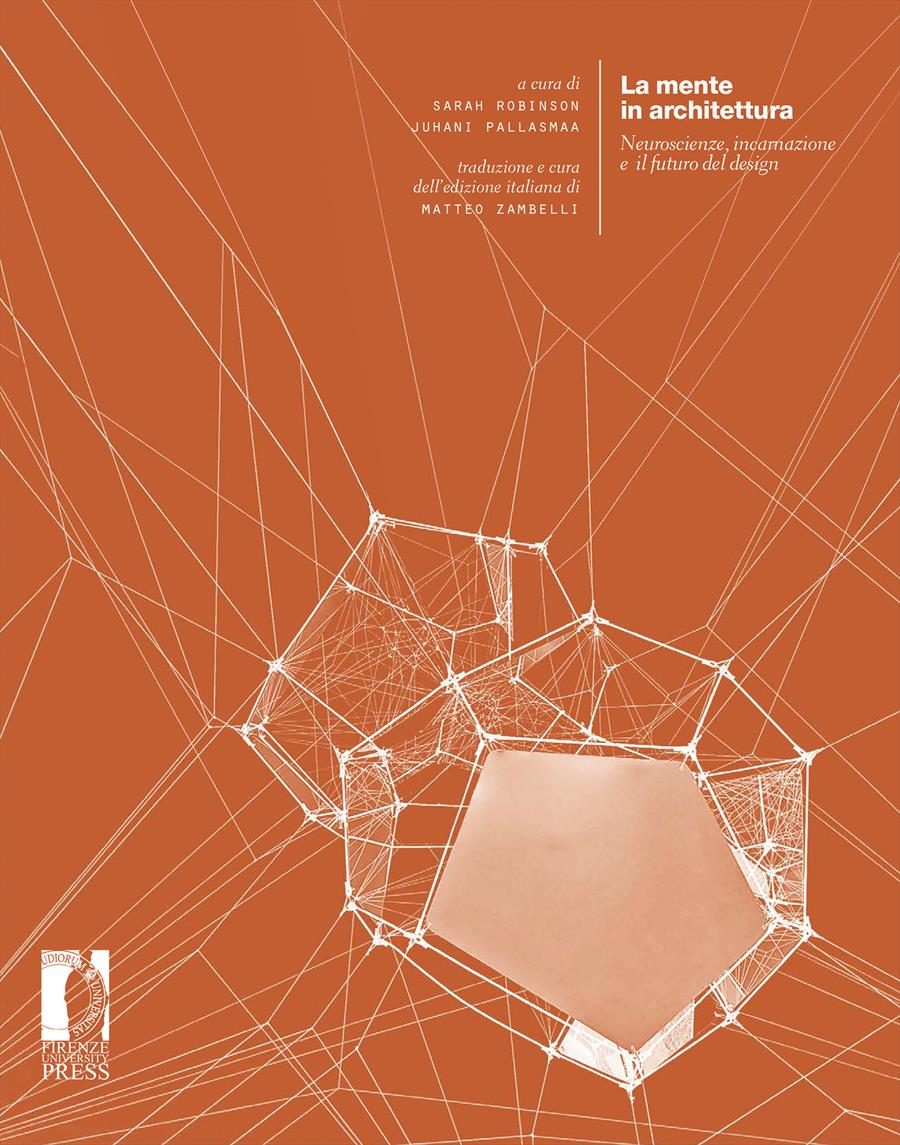- La mente in architettura
- Edited by Sarah Robinson, Juhani Pallasmaa, Matteo Zambelli
Il significato incarnato dell’architettura
- Mark L. Johnson
- © 2021 Author(s) |
- CC BY-NC-SA 4.0
- DOI: 10.36253/978-88-5518-286-7.04
Reflects on the nature of human meaning making through architecture. Meaning mak-ing is understood to be situated, relational, qualitative, dynamic and enacted. To appre-ciate the significance of architecture we need to understand how meaning is structured through the body. Some image-body schemas include containment, verticality, balance, forces and motion. Architecture’s moral imperative is to creatively transform the condi-tions of human habitation and interaction.
- Keywords:
- Meaning making,
- ecological logic,
- body schemas,
- philosophy in the flesh,
- enactive rela-tion,
- image-schematic,
University of Oregon, United States
- Alexander Thomas M. 2013, The Human Eros: Eco-ontology and the Aesthetics of Existence, Fordham University Press, New York.
- Barsalou L.W. 1999, “Perceptual Symbol Systems”, in «Behavioral and Brain Sciences» n. 22, p. 577.
- Bergen Benjamin, Louder Than Words: The New Science of How the Mind Makes Meaning, Basic Books, New York, 2012.
- Damasio Antonio 2012, Il sé viene alla mente. La costruzione del cervello cosciente, Adelphi, Milano.
- Dewey John 1987, “Qualitative Thought”, in «The Later Works» 1925–1953, Vol. v, Southern Illinois University Press, Carbondale, p. 24.
- Dewey John 2007, Arte come esperienza, Aesthetica Edizioni, Palermo.
- Feldman Jerome 2006, From Molecule to Metaphor: A Neural Theory of Language,The MIT Press, Cambridge, Massachusetts.
- Flanagan Owen 2007, The Really Hard Problem: Meaning in a Material World, The MIT Press, Cambridge, Massachusetts.
- Gallese V., Goldman A. 1998, “Mirror Neurons and the Simulation Theory of Mind-Reading”, in «Trends in Cognitive Science» n. 2, pp. 455-479.
- Gallese V., Lakoff G. 2005, “The Brain’s Concepts: The Role of the Sensory-Motor System in Conceptual Knowledge”, in «Cognitive Neuropsychology» n. 21, pp. 1-25.
- Gibson James J. 2014, L’approccio ecologico alla percezione visiva, Mimesis Edizioni, Milano-Udine.
- Heidegger Martin 1995, “L’origine dell’opera d’arte”, in L’origine dell’opera d’arte di Heidegger e il problema della verità, a cura di Veniero Venier, Paravia, Torino.
- Johnson Mark 2007, The Meaning of the Body: Aesthetics of Human Understanding, University of Chicago Press, Chicago.
- Johnson Mark 2014, Morality for Humans: Moral Understanding from the Perspective of Cognitive Science, University of Chicago Press, Chicago.
- Lakoff George, Johnson Mark 1990, Philosophy in the Flesh: The Embodied Mind and its Challenge to Western Thought, Basic Books, New York.
- Pallasmaa Juhani 2011, Lampi di pensiero, Edizioni Pendragon, Bologna.
- Pallasmaa Juhani 2014, La mano che pensa, Safarà Editore, Pordenone.
- Pérez-Gómez A. 2002, “Phenomenology and Virtual Space: Alternative Tactics for Architectural Practice”, in «OASE» n. 58, p. 36.
- Ricoeur Paul 2008, Tempo e racconto, 1, Jaca Book, Milano.
- Rizzolatti G., Craighero L. 2004, “The Mirror-Neuron System”, in «Annual Review of Neuroscience» n. 27, pp. 169-192.
- Sheets-Johnstone Maxine 1999, The Primacy of Movement, John Benjamins, Amsterdam.
- Vesely D. 2002, “Space, Simulation and Disembodiment in Contemporary Architecture”, in «OASE» n. 58, p. 66.
Chapter Information
Chapter Title
Il significato incarnato dell’architettura
Authors
Mark L. Johnson
Language
Italian
DOI
10.36253/978-88-5518-286-7.04
Peer Reviewed
Publication Year
2021
Copyright Information
© 2021 Author(s)
Content License
Metadata License
Bibliographic Information
Book Title
La mente in architettura
Book Subtitle
Neuroscienze, incarnazione e il futuro del design
Editors
Sarah Robinson, Juhani Pallasmaa, Matteo Zambelli
Peer Reviewed
Number of Pages
240
Publication Year
2021
Copyright Information
© 2021 Firenze University Press
Content License
Metadata License
Publisher Name
Firenze University Press
DOI
10.36253/978-88-5518-286-7
ISBN Print
978-88-5518-285-0
eISBN (pdf)
978-88-5518-286-7
eISBN (xml)
978-88-5518-287-4
Series Title
Ricerche. Architettura, Pianificazione, Paesaggio, Design
Series ISSN
2975-0342
Series E-ISSN
2975-0350
